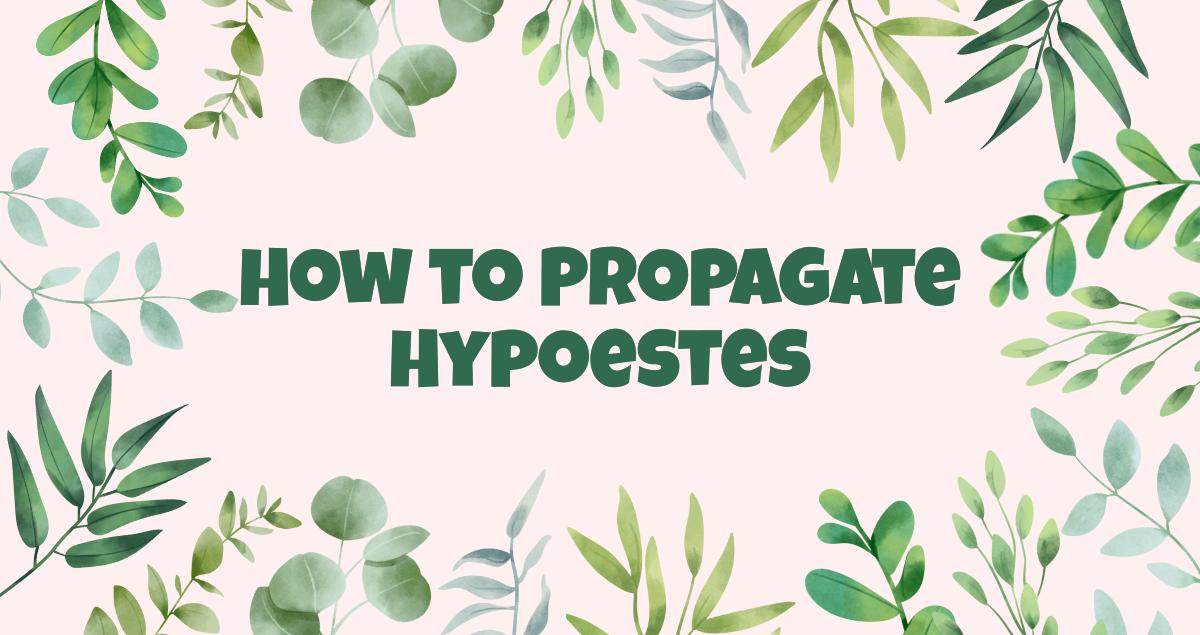Propagation is an essential part of growing hypoestes, also known as polka dot plant. This popular houseplant is known for its vibrant foliage, featuring colorful spots or dots on its leaves. Understanding how to propagate hypoestes is a valuable skill for any plant enthusiast, as it allows you to create new plants from existing ones and expand your collection.
Table of Content
How to Propagate Hypoestes
To propagate hypoestes, take stem cuttings from a healthy plant, remove the lower leaves, dip the cut end in rooting hormone, and plant it in a well-draining potting mix. Keep the cutting in a warm and humid environment, misting it regularly. After a few weeks, the cutting should develop roots, and it can be transferred to a larger pot or garden bed.
Understanding Hypoestes
Hypoestes is a genus of flowering plants in the family Acanthaceae, native to Madagascar and Southeast Asia. The most commonly cultivated species is Hypoestes phyllostachya, which is valued for its attractive foliage. The leaves of hypoestes come in various colors, including pink, red, white, and green, with contrasting spots or dots. This plant is typically grown as a houseplant or in outdoor gardens in warm climates.
Propagation Methods
There are several methods you can use to propagate hypoestes, including stem cutting, leaf cutting, division, and seed propagation. Each method has its own advantages and requirements, so it's important to choose the one that suits your needs and resources.
1. Stem Cutting
Stem cutting is a common and effective method for propagating hypoestes. To propagate hypoestes through stem cuttings, select a healthy stem from the parent plant and cut it just below a node. Remove any leaves from the lower portion of the cutting and dip the cut end in a rooting hormone. Plant the cutting in a well-draining potting mix and keep it moist until roots develop.
2. Leaf Cutting
Leaf cutting is another method you can use to propagate hypoestes. Select a healthy leaf from the parent plant and cut it close to the stem. Place the leaf in a container with moist potting mix, burying the stem end slightly. Keep the soil consistently moist and provide indirect light. After a few weeks, new roots will develop, and a new plant will start to grow.
3. Division
Division is a method that works well for mature hypoestes plants with multiple stems. Carefully remove the plant from its pot and gently separate the root ball into two or more sections, making sure each section has roots and stems. Plant each division in its own pot with fresh potting mix and water thoroughly. Place the newly divided plants in a bright location, away from direct sunlight, and keep the soil evenly moist.
4. Seed Propagation
Seed propagation is a more time-consuming method but can be rewarding if you have the patience. Collect the seeds from mature hypoestes plants and sow them in a seed-starting mix. Cover the seeds lightly with soil and keep the soil consistently moist. Place the container in a warm location with indirect light. It may take several weeks for the seeds to germinate, and once they do, you can transplant the seedlings into individual pots.
Preparing for Propagation
Before you start the propagation process, there are a few important steps you should take to ensure success.
1. Selecting Healthy Parent Plants
Choose healthy hypoestes plants with vibrant foliage and no signs of disease or pests. Healthy parent plants will produce strong and vigorous offspring.
2. Gathering Necessary Tools and Materials
Make sure you have all the tools and materials you need for successful propagation. This may include sharp scissors or pruning shears, clean pots or containers, well-draining potting mix, rooting hormone, and a spray bottle for misting.
Step-by-Step Propagation Process
1. Stem Cutting
To propagate hypoestes using stem cuttings, follow these steps:
- Select a healthy stem from the parent plant.
- Cut the stem just below a node using sharp scissors or pruning shears.
- Remove any leaves from the lower portion of the cutting.
- Dip the cut end of the stem in rooting hormone.
- Plant the cutting in a well-draining potting mix.
- Keep the soil moist and provide indirect light.
- After a few weeks, roots will develop, and the cutting will start to grow.
2. Leaf Cutting
To propagate hypoestes using leaf cuttings, follow these steps:
- Select a healthy leaf from the parent plant.
- Cut the leaf close to the stem using sharp scissors or pruning shears.
- Place the leaf in a container with moist potting mix, burying the stem end slightly.
- Keep the soil consistently moist and provide indirect light.
- After a few weeks, new roots will develop, and a new plant will start to grow.
3. Division
To propagate hypoestes through division, follow these steps:
- Carefully remove the plant from its pot.
- Gently separate the root ball into two or more sections, ensuring each section has roots and stems.
- Plant each division in its own pot with fresh potting mix.
- Water thoroughly and place the newly divided plants in a bright location, away from direct sunlight.
- Keep the soil evenly moist until the plants establish.
4. Seed Propagation
To propagate hypoestes from seeds, follow these steps:
- Collect seeds from mature hypoestes plants.
- Sow the seeds in a seed-starting mix, covering them lightly with soil.
- Keep the soil consistently moist and place the container in a warm location with indirect light.
- It may take several weeks for the seeds to germinate.
- Once the seedlings have developed, transplant them into individual pots.
Caring for Newly Propagated Hypoestes
1. Transplanting
When transplanting newly propagated hypoestes, follow these guidelines:
- Choose a pot that is slightly larger than the root ball.
- Fill the pot with fresh potting mix.
- Remove the plant from its current container and gently loosen the roots.
- Place the plant in the new pot and fill in the gaps with more potting mix.
- Water the plant thoroughly after transplanting.
2. Watering and Humidity
Proper watering and humidity levels are important for the health of newly propagated hypoestes. Keep the soil evenly moist, but not waterlogged, to prevent root rot. Mist the leaves regularly to provide the necessary humidity for the plant.
3. Light and Temperature
Newly propagated hypoestes plants require bright, indirect light to thrive. Avoid placing them in direct sunlight, as it can scorch the leaves. Maintain a temperature between 65-75°F (18-24°C) for optimal growth.
Common Challenges and Troubleshooting
1. Rooting Failure
If your hypoestes cuttings or divisions fail to root, there could be several reasons:
- Improper cutting technique: Make sure you are using sharp, clean tools and cutting just below a node.
- Inadequate moisture: Ensure the soil is consistently moist, but not overly wet.
- Low humidity: Mist the cuttings or divisions regularly to provide the necessary humidity.
- Incorrect temperature: Maintain a warm temperature for successful rooting.
2. Disease and Pest Control
Hypoestes plants can be susceptible to certain diseases and pests, including powdery mildew, spider mites, and aphids. To prevent and treat these issues:
- Ensure good air circulation around the plants.
- Regularly inspect the leaves for any signs of pests or disease.
- If necessary, treat with appropriate organic or chemical controls.
Conclusion
Propagation is a rewarding way to expand your collection of hypoestes plants. By understanding the different propagation methods and following the necessary steps, you can successfully propagate hypoestes through stem cuttings, leaf cuttings, division, or seed propagation. Remember to provide the right care and conditions for the newly propagated plants, and troubleshoot any issues that may arise. With proper attention, you can enjoy a thriving collection of hypoestes plants in your home or garden.
Frequently Asked Questions
Can you propagate Hypoestes in water?
Yes, you can propagate Hypoestes in water. Simply take a stem cutting from a healthy plant, remove the lower leaves, and place the cutting in a container filled with water. Make sure to change the water regularly to prevent any bacterial growth.
How do you propagate Hypoestes from cuttings?
To propagate Hypoestes from cuttings, start by taking a stem cutting from a mature and healthy plant. Remove the lower leaves and dip the cut end in a rooting hormone. Plant the cutting in a well-draining potting mix and keep it moist. Place the pot in a warm and bright location, and roots should develop within a few weeks.
Should I propagate polka dot plant in water or soil?
You can propagate polka dot plant in both water and soil. Water propagation is a popular method where you place the stem cutting in water until roots develop. Alternatively, you can directly plant the cutting in a well-draining potting mix and keep it moist until roots establish.
How do you keep Hypoestes from getting leggy?
To prevent Hypoestes from becoming leggy, it is important to provide it with sufficient light. Place the plant in a bright location, but avoid direct sunlight as it can scorch the leaves. Regularly pinch back the growing tips to encourage bushier growth and remove any leggy stems to maintain a compact appearance.
What is the best time to propagate Hypoestes?
The best time to propagate Hypoestes is during the spring or early summer when the plant is actively growing. This allows the cutting to establish roots more easily and increases the chances of successful propagation.
Can I propagate Hypoestes from seeds?
Yes, you can propagate Hypoestes from seeds. Collect the seeds from a mature plant and sow them in a well-draining potting mix. Keep the soil consistently moist and provide warmth and bright indirect light. Germination should occur within a few weeks, and once the seedlings are large enough, they can be transplanted into individual pots.
How long does it take for Hypoestes cuttings to root?
Hypoestes cuttings usually take around 2 to 4 weeks to develop roots. However, the rooting time can vary depending on various factors such as temperature, humidity, and the health of the cutting. It is important to keep the cutting in a warm and moist environment to promote root growth.

